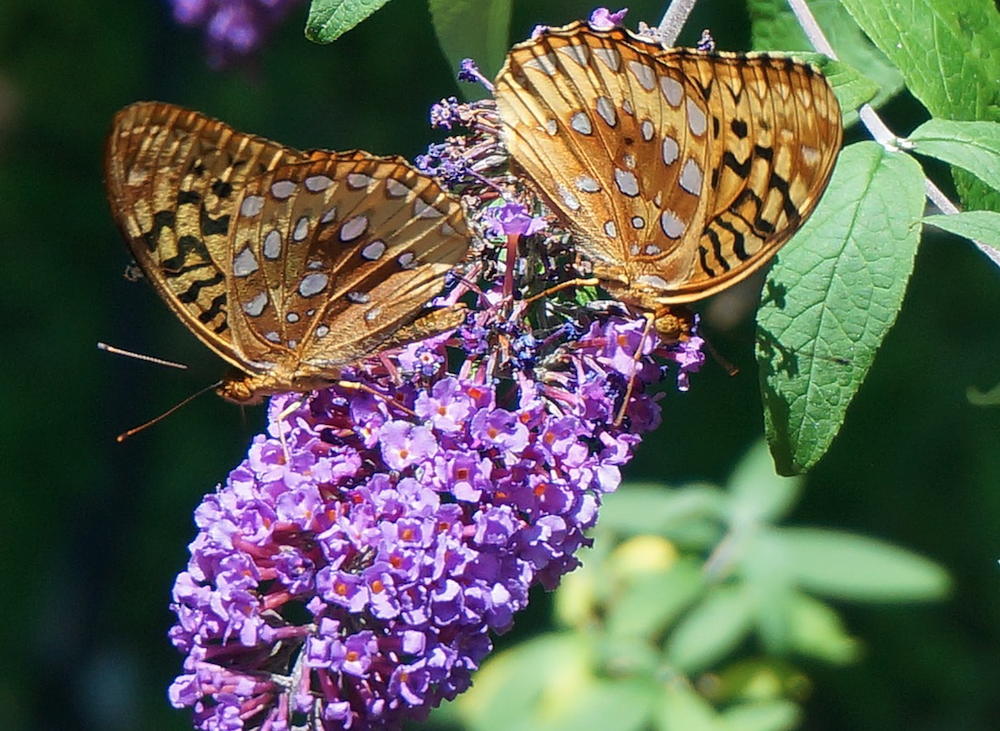Tell the PC Police to Leave the Butterfly Bush Alone!
By Linda Lee

Buddleia, or butterfly bush – also known as “summer lilac,” suddenly has a bit of controversy surrounding this lovely shrub.
The PC police believe that because buddleia is so attractive to pollinators it will distract them from native plants. (These same people would object to hummingbird feeders, I assume.) Also, they say, it is “invasive.”
Yes, it will seed itself freely, but not if you mow the grass. How many buddleias have YOU found growing higgledy-piggledy like purple loosestrife? None, by my count.
As for distracting pollinators, the argument could be made for lilacs, roses, peonies, any other sweet-smelling flowers at a much more important time, the spring, when apple and cherry trees need pollinating.
In the heat of summer, what exactly are pollinators distracted from doing by a butterfly bush? Right now I find a lot of pollinators getting distracted by the hostas in my front yard, the flowerpots, the zinnias and cleome and daylilies. Even the salvia. Anything I plant is going to distract from the native plants, yes?
I feel sorry for those who selectively go after a “foreign” bush-like buddleia – it came from China – while ignoring, say, the tulip, peony, song sparrow and the endless other things in our lives that come from somewhere else. Leave us alone and go grow your own green tea leaves.
The critics argue that despite the “butterfly” name, this shrub doesn’t support butterfly reproduction and it only provides nectar to adult butterflies.
Okay. So plant some asters, bee balm, goldenrod, milkweed, viburnum or yarrow as well which helps growing caterpillars turn into butterflies. Also read Wendy Williams’ book, “The Language of Butterflies” which tracks how butterflies grow and what flowers they are attracted to during their life cycles. But it includes the Butterfly Bush.
It’s not too late in the season to plant a butterfly bush. Here’s why. Nurseries will still have them, some stunning new ones, too. And some are marked down!
Furthermore, these bushes are delightfully fragrant. And they come in a variety of colors and sizes.
Proven Winners has a series called Pugster® which features full-sized flowers on a dwarf habit (2’ tall/wide). That means you can put them in a garden or even on a city patio. These extra-large, highly fragrant blooms bring butterflies flocking from miles around. As an added bonus, thick, sturdy stems make the Pugster® series of woody Buddleia less brittle, improving winter survival in colder climates.
For those who like something more unique, the Pugster Pinker™ has very rich pink flowers, each with a tiny bright orange eye in the center. Whatever you choose, each member of the series blooms non-stop from early summer through frost.
TIPS FOR PLANTING
The butterfly bush has beautiful flowers in purple, white and lavender as well as pink – and likes it dry. This is a bush that, yes, attracts butterflies, and will grow to impressive heights up to 15 feet tall. Colors include a deep purple (Black Knight from www.springhillnursery.com), feathery whites, a bicolor from www.Naturehills.com that blooms in lavender and peach-yellow and Kaleidoscope, also from Spring Hill. Proven Winners came out with Pugster in 2021, a deep amethyst that can be found at nurseries and Home Depots.
So let’s get the thing planted.
Do not stick it in a wet spot. And please, not in the shade. This is a plant that wants full sun, at least eight hours a day. It can be a nice addition along a fence and, within a few years, will make a good amount of summer screening from the street or from neighbors.
About planting. Of course, dig a nice deep hole. Then fill most of it in. This is a bush that you want to sit a little above the hole. You do not want its roots to get wet. Root rot is the enemy. So instead of the ring that would dig around a tree, to catch water, you are going to treat a buddleia more like a pumpkin. Put it on a hill to make it happy.
This time of year it might still be blooming. Dead-head any spent blooms, so the plant will kick into gear and do what angiosperms are meant to do: make flower heads. A buddleia can be planted any time between now and the dead of winter. But don’t prune it back until spring.
The butterfly bush, which grows from zones 5 to 8, basically Massachusetts to Georgia, is a happy companion to a porch, or a walkway, a way to watch hummingbirds without refilling a bird feeder. The flowers’ cheerful fingers seem to wink at you, saying “Not every late-summer flower has to be yellow or gold!”

Linda Lee is a former editor at The New York Times. She was the deputy editor of the House & Home section and wrote frequently for Sunday Styles.
